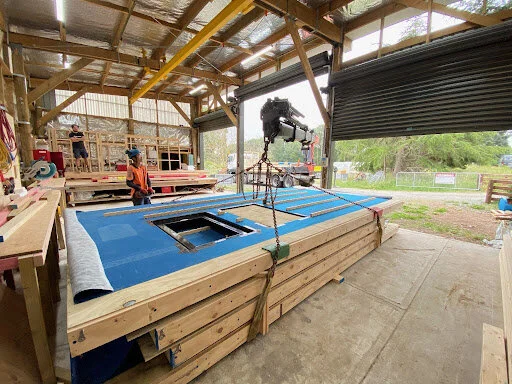Choosing the right materials to create the best possible home
Or, why I don’t use SIP
Wool insulation, made from the fleece of the sheep grazing in the next door paddock, not fibreglass.
The most natural paints you can buy, instead of stinky formulations that fill the house with VOCs.
Wool carpets made in New Zealand rather than nylon underfoot.
Durable decking and cladding from Abodo replacing pine treated with toxic chemicals.
And last but very much not least, timber framing. Not structural insulated panels (SIP) or insulated concrete forms (ICF).
Photo: Ernst Frei
These are the choices made by the team that is bringing you New Zealand’s first Passive House neighbourhood, Bushland Park (above). Landowner Ernst Frei had an audacious dream that motivated this retired organic farmer and avid tree planter to become a property developer. He brought in Ethos Homes, who in turn engaged Karen Manson from Meta Architects, to create the best possible houses—for the families that will call them home and for the environment we all share.
I’ve been building for 22 years. I learnt prefabrication and high-performance building in Germany, from the most fastidious (picky) craftsmen you can imagine. When I came back, I started my own company so I could put that learning into practice. At Ethos Homes, we just build high-performance homes—preferably certified Passive House but always well above the Building Code*. We also do retrofits to existing homes. I’m proud to be a certified Passive House tradesman and of our track record of building outstanding, certified Passive House homes.
I don’t build with SIPs. There are a number of benefits to using them, but they’re a big foam sandwich, and it’s that polyurethane or polystyrene layer in the middle that I just don’t like. There’s even more fossil fuel being burned if they are being imported from overseas.
Using timber framing means my team is in control of the whole process, rather than having another supply chain to manage and contractor to rely on. With the current shortage of building materials and shipping delays, I don’t need extra stress. I also like being in charge of quality control. Building our way, I am absolutely confident about the timber content in the walls (this is a bit technical, but the short version is this percentage is crucial to meeting Passive House targets). And if a client wants a last minute variation, we can do that on the spot. There’s no adding an extra window into a SIP wall!
One more benefit: we are using timber from trees grown right here in New Zealand. It stored carbon while it grew and we’re locking up that carbon for generations by using the timber in high-quality homes that are built to last.
Photo: Ethos Homes
SIPs are fast to put up but we get that benefit by pre-fabricating modular panels in a factory we’ve set up onsite at Bushland Park (above). There both my team and the materials are protected from the weather and work is both fast and precise. The modular construction is one of the benefits of masterplanning this beautiful neighbourhood. The owners get the benefit of an architecturally designed house at a fixed and fair price because modular prefab keeps costs down and saves labour time on site.
We went into Level 4 lockdown just two days after the crane arrived and we started standing up the panels for the first two builds, the two Rātā homes. You can bet I was itching to get back to it—and so we did, on the first day of Level 3. It’s all go now.
*Keep in mind, “built to Code” just means it’s the worst house you can legally build. As my wife Amanda puts it, we don’t want to be responsible for adding to the burden of cold, damp, unhealthy homes. We want our own kids to grow up to have better options for where and how they live.


